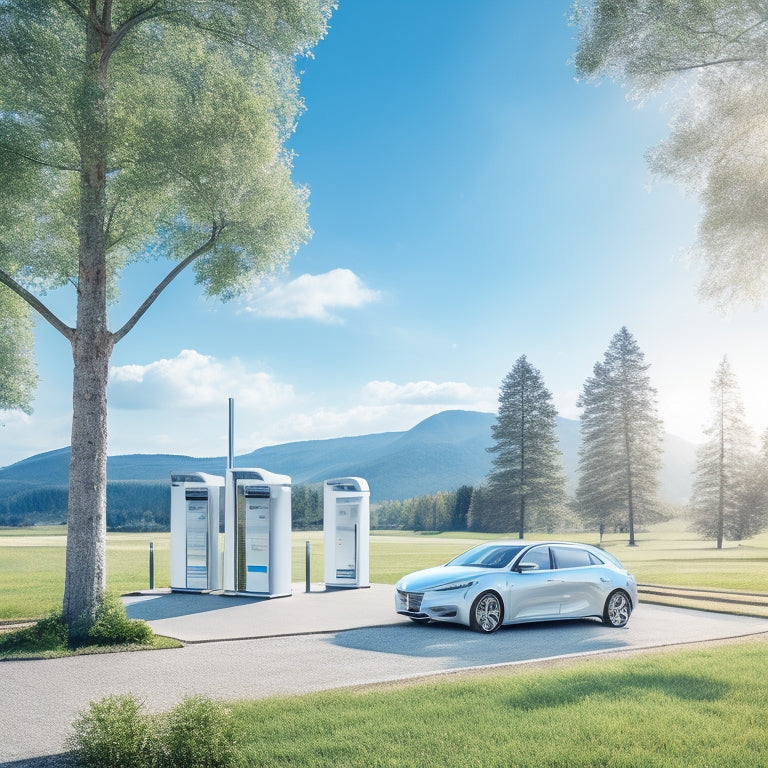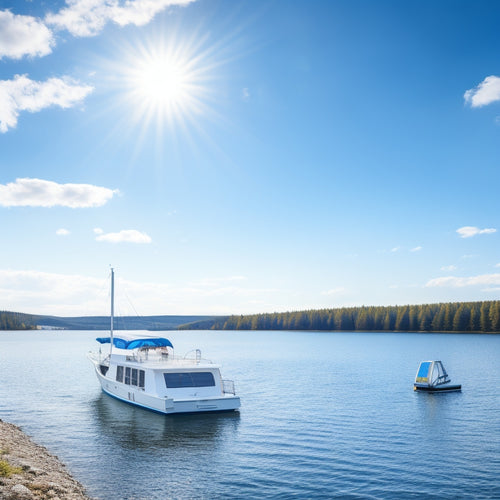
Top 10 Ways to Charge Your EV With Sunlight
Share
You can charge your EV with sunlight in various ways. For starters, you can install rooftop solar panels, considering factors like panel durability and roof structure. Alternatively, you can use solar car charging stations, prioritizing station design and panel efficiency. Portable solar EV chargers offer convenience, while grid-tied systems help optimize energy production. You'll also want to maintain your EV's battery health and adjust your solar panels for seasonal changes. Understanding charging timeframes and cost savings will help you make the most of solar energy. As you explore these options, you'll discover more ways to harness the sun's power to fuel your EV adventure.
Key Takeaways
• Install rooftop solar panels with sufficient sunlight and structurally sound roofs to maximize energy production for EV charging.
• Utilize solar car charging stations with efficient designs, canopy orientation, and shade mitigation to enhance energy harvesting.
• Invest in portable solar EV chargers with high-efficiency solar panels, quality photovoltaic cells, and compact designs for on-the-go charging.
• Optimize solar panel angles by adjusting tilt and azimuth for maximum energy output, considering seasonal changes and sun position.
• Consider DIY kits or grid-tied systems, which can be customized to energy needs and space, offering cost-effective and efficient solar EV charging solutions.
Harnessing Solar Power for EVs
You can convert sunlight into electricity to fuel your EV, thanks to innovative solar panel systems that integrate seamlessly with electric vehicle charging infrastructure. This synergy enables you to harness renewable energy and reduce your carbon footprint.
As you explore this eco-friendly option, you'll discover attractive Solar Incentives that can offset the initial investment costs. For instance, the Solar Investment Tax Credit (ITC) allows you to claim a tax credit of up to 26% of the total solar panel system cost.
Vehicle Integration is a critical aspect of this setup, as it guarantees a smooth and efficient energy transfer from the solar panels to your EV's battery. This integration enables real-time monitoring and optimization of energy production and consumption, allowing you to maximize your solar energy usage.
Installing Rooftop Solar Panels
Rooftop solar panels can be installed on most homes, provided the roof receives sufficient sunlight and is structurally sound to support the added weight of the panels. Before installation, a thorough roof assessment is necessary to guarantee your roof is suitable for solar panels. This assessment will evaluate the roof's size, orientation, and condition to determine the best placement of the panels. A professional installer will also inspect your roof's structural integrity to confirm it can support the weight of the panels.
When selecting solar panels, consider panel durability as a top priority. Look for panels with a durable anodized aluminum frame, tempered glass, and a long-lasting waterproof seal. This will ensure your panels withstand various weather conditions and last for years to come. A reputable installer will guide you through the selection process, helping you choose the right panels for your specific needs.
With the right installation and panel selection, you'll be harnessing sunlight to charge your EV in no time.
Solar Car Charging Stations
As you explore solar car charging stations, you'll notice that the design of the station itself plays a vital role in harnessing sunlight efficiently.
You'll want to contemplate factors like canopy orientation, shade mitigation, and electrical infrastructure to guarantee maximum energy harvesting.
Moreover, the effectiveness of the solar panels used in these stations will directly impact the speed and reliability of your EV's charge.
Station Design Considerations
Solar car charging stations demand meticulous planning and design to guarantee efficient energy harvest and convenient charging experiences. A well-designed station layout is vital to achieving these goals. As you plan your solar car charging station, it's crucial to take into account the overall design and layout to ensure a seamless user experience.
When it comes to station design, you should prioritize the following key considerations:
-
Aesthetic Integration: Make sure that the station's design blends seamlessly with its surroundings. Incorporate features like green roofs, living walls, or public art installations to create an inviting atmosphere.
-
Urban Placement: Strategically position the station in high-traffic areas, such as shopping centers, public parking lots, or along highways, to maximize visibility and accessibility.
-
Accessibility and Safety: Design the station with clear signage, ample lighting, and well-maintained walkways to guarantee a safe and convenient charging experience for users.
Solar Panel Efficiency
Optimize your solar car charging station's energy output by selecting high-efficiency solar panels that can convert sunlight into electrical energy with minimal loss. With the rapid advancement of Solar Cell Innovation, you can now harness more energy from the sun than ever before. Photovoltaic Breakthroughs have led to the development of high-efficiency solar panels that can convert up to 22% of sunlight into electrical energy.
When selecting solar panels for your charging station, consider the following factors:
| Efficiency | Description |
|---|---|
| 15% | Standard Efficiency, suitable for most charging stations |
| 18% | High-Efficiency, ideal for smaller charging stations |
| 20% | Premium Efficiency, perfect for large-scale charging stations |
| 22% | Ultra-High Efficiency, for maximum energy output |
Portable Solar EV Chargers
When exploring the world of portable solar EV chargers, you'll want to take into account the efficiency of the solar panels, which directly impacts how quickly you can charge your vehicle.
You'll also need to think about portability and design, as a charger that's too bulky or heavy may not be convenient for on-the-go charging.
Solar Panel Efficiency
Your portable solar EV charger's performance relies heavily on the efficiency of its solar panels, which can vary greatly depending on the type and quality of photovoltaic cells used. When it comes to harnessing sunlight to charge your EV, every percentage point of efficiency counts.
To maximize energy generation, it's crucial to understand the factors that impact solar panel efficiency. Here are three key considerations:
-
Panel Temperature: High temperatures can greatly reduce solar panel efficiency. Look for chargers with built-in cooling systems or those designed to operate efficiently in hot climates.
-
Energy Loss: Energy loss occurs when sunlight is reflected or absorbed by the panel's surface. Opt for chargers with anti-reflective coatings or textured surfaces to minimize energy loss.
-
Cell Quality: The quality of photovoltaic cells directly affects efficiency. Choose chargers with high-efficiency cells, such as monocrystalline or bifacial cells, to get the most out of your solar power.
Portability and Design
When selecting a portable solar EV charger, considering its design and portability features is essential, as you'll need to easily transport and deploy it in various environments. A well-designed charger will allow you to effortlessly move it to the most sun-exposed areas, maximizing energy harvesting. Look for foldable frames that can be easily set up and taken down, making it convenient to recharge your EV anywhere.
Aesthetic integration is also important, as it enhances the overall user experience. A sleek and modern design will seamlessly blend with your vehicle's exterior, making it an attractive addition to your eco-friendly setup. In addition, a charger with a compact footprint will occupy minimal space, ensuring it doesn't obstruct your vehicle's functionality.
When evaluating portability, consider the charger's weight, dimensions, and carrying case. A lightweight and compact design will make it easy to transport, while a durable carrying case will protect it during transit.
Solar EV Battery Maintenance
You'll need to monitor your solar EV battery's state of charge regularly to guarantee peak performance and extend its lifespan. Proper maintenance is essential to make sure your battery remains healthy and efficient. Neglecting maintenance can lead to reduced capacity, decreased range, and even complete battery failure.
To maintain peak Battery Health, focus on the following:
-
Cell Balancing: Ensure that each cell is charged and discharged evenly to prevent overcharging or undercharging, which can cause permanent damage.
-
Avoid Extreme Temperatures: High or low temperatures can affect your battery's performance and lifespan. Park your EV in shaded areas or use a temperature-controlled charging station when possible.
-
Update Your Battery Management System (BMS): Regularly update your BMS software to make sure you have the latest features and improvements, which can enhance your battery's performance and longevity.
Solar Panel Angle Optimization
Optimizing the angle of your solar panels is crucial to maximize energy harvesting, as misaligned panels can significantly reduce energy output and hinder your electric vehicle's charging capacity. By adjusting the angle of your solar panels, you can increase energy production and guarantee your EV is charged efficiently.
To achieve peak energy harvesting, consider the following factors:
| Factor | Adjustment |
|---|---|
| Latitude | Tilt at an angle equal to your latitude to maximize winter energy production |
| Azimuth | Adjust azimuth to face true south (in the northern hemisphere) for maximum energy output |
| Seasonal | Adjust angle seasonally to account for changes in the sun's position |
EV Solar Charging Timeframes
When you plan your solar-powered EV charging, it's important to understand the timeframe for replenishing your vehicle's battery, which depends on several factors, including your EV's charging capacity and the amount of energy your solar panels can produce.
The charging timeframe can vary considerably depending on the time of day, season, and your location. For instance:
-
Peak solar hours: During peak solar hours (usually between 9 am and 3 pm), your solar panels can produce the most energy, resulting in faster charging times.
-
Charging seasons: In regions with distinct seasons, the amount of sunlight available affects your charging speed. For example, summer months typically provide more sunlight, leading to faster charging, while winter months may require more time to recharge.
-
Solar windows: If you have limited solar windows (e.g., due to shading or obstructions), your charging time will be longer, as your panels can only produce energy during these periods.
Solar EV Charging Cost Savings
By harnessing sunlight to charge your EV, you can greatly reduce your reliance on the grid and lower your electricity bills. This not only benefits the environment but also your wallet. The cost benefits of solar EV charging are significant, and you can expect to save a substantial amount on your energy costs.
According to various studies, solar-powered EV charging can save you up to 80% on your energy bills, depending on your location and energy usage. Additionally, many governments offer financial incentives for those who invest in solar-powered EV charging systems, further reducing the overall cost. These incentives can include tax credits, rebates, and low-interest loans, making it even more attractive to switch to solar.
DIY Solar EV Charging Kits
You can install a DIY solar EV charging kit, which typically includes a solar panel array, a charge controller, and an inverter, to harness sunlight and power your electric vehicle. This option provides a cost-effective and customizable solution for EV owners who want to reduce their reliance on the grid. With a DIY kit, you can choose the components that best fit your needs and budget.
Some benefits of DIY solar EV charging kits include:
-
Kit customization: Tailor your system to your specific energy requirements and available space.
-
Cost-effective: DIY kits can be more affordable than pre-assembled systems.
-
DIY warranties: Many manufacturers offer warranties on individual components, providing peace of mind for your investment.
When selecting a DIY kit, consider factors like the quality of the components, the warranty offered, and the level of customer support provided. By choosing the right kit and installing it correctly, you can enjoy the benefits of solar-powered EV charging while minimizing your environmental footprint.
Grid-Tied Solar EV Systems
When you're designing a grid-tied solar EV system, you'll need to take into account two critical factors:
the orientation of your solar panels and the system's overall size.
You'll want to optimize your panel orientation to maximize energy production, taking into consideration your location's latitude, roof pitch, and potential shading.
Solar Panel Orientation
Ideally angled solar panels can increase energy production by up to 46% in grid-tied solar EV systems. As you consider your solar panel orientation, remember that essential positioning is vital for maximizing energy production. You'll want to adjust your solar panels to accommodate the changing sun patterns throughout the year.
To get the most out of your solar panels, consider the following adjustments:
-
Azimuth adjustment: Adjust the direction of your solar panels to face the best direction, taking into account any obstacles or shading.
-
Seasonal tilt: Tilt your solar panels to match the changing angle of the sun throughout the year, with a steeper tilt in winter and a shallower tilt in summer.
-
Row spacing and panel height: Guarantee adequate spacing between rows and adjust the height of your solar panels to minimize shading and optimize energy production.
System Sizing Considerations
Properly sizing your grid-tied solar EV system guarantees it can meet your electric vehicle's energy demands while also optimizing your energy production.
When it comes to system sizing, you'll need to take into account your EV's energy requirements, which can vary depending on factors like your daily driving habits and the efficiency of your vehicle. Additionally, you'll need to evaluate your roof's solar potential, considering shading, orientation, and available space.
To make sure your system can meet your energy needs, you'll need to identify any system constraints, such as inverter capacity, wiring, and electrical panel limitations.
Conducting an energy audit can help you pinpoint areas of energy inefficiency in your home, allowing you to optimize your energy usage and maximize your solar energy production.
By taking these factors into account, you can design a system that not only meets your EV's energy demands but also minimizes your reliance on the grid.
A well-designed system will ensure you're driving on sunshine while keeping your energy bills in check.
Frequently Asked Questions
Can I Use Solar Power to Charge My EV at Night?
You can't directly use solar power to charge your EV at night, but you can store excess energy in your battery during the day for nighttime charging or consider battery swapping for convenient refueling.
Are Solar Panels Affected by Extreme Temperatures?
'Can you imagine harnessing the sun's energy, only to have it compromised by extreme temperatures? Solar panels are affected by heat, with heat resistance and temperature coefficients impacting their efficiency, so you'll want to take into account these factors when installing your system.'
Can I Charge My EV With Solar Power During a Blackout?
During a blackout, you can charge your EV with solar power if you have a grid-tied system with backup capabilities, ensuring grid resilience and allowing you to harness sunlight even when the grid is down.
Do Solar Panels Require Regular Cleaning for Optimal Performance?
'As you bask in the radiant glow of your solar panels, remember that dust accumulation can silently sabotage their performance. Regular panel maintenance is essential to guarantee top energy harvesting, so don't let grime get in the way of your eco-friendly endeavors.'
Can I Sell Excess Solar Power Back to the Grid?
You can sell excess solar power back to the grid through Net Metering, earning Grid Credits that offset your energy consumption, allowing you to maximize your solar investment and reduce your carbon footprint.
Related Posts
-

Why Cheap Solar Panels Aren't Always the Best
When opting for cheap solar panels, you're likely sacrificing quality and reliability for upfront savings. However, y...
-

What's the Best Green Ride for College Budgets?
As a college student on a budget, you're likely looking for an eco-friendly ride that won't break the bank. You've go...
-

Selecting Solar Panel Kits for Boat and RV Owners
When selecting a solar panel kit for your boat or RV, you'll want to calculate your daily energy consumption in watt-...


